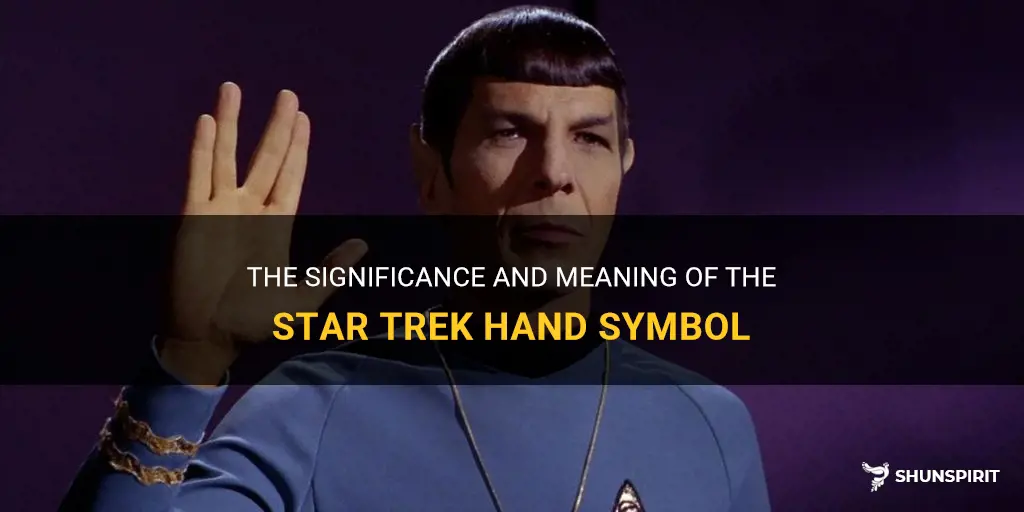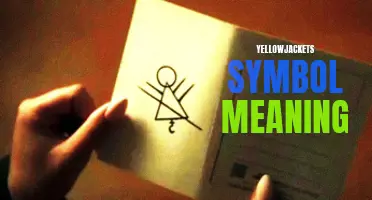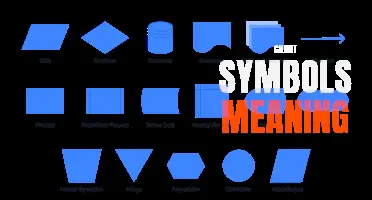
If there is one symbol that instantly transports us to the futuristic universe of Star Trek, it is the famous hand sign. With a simple gesture, the iconic hand symbol became synonymous with the famous greeting live long and prosper and came to represent the ideals of peace, logic, and unity in the Star Trek universe. But where did this symbol originate, and what does it truly mean? Join me on this journey to uncover the mysteries behind the Star Trek hand symbol, as we explore its historical significance and its profound impact on popular culture.
What You'll Learn
- What is the origin of the Star Trek hand symbol?
- How did the Star Trek hand symbol become popularized?
- What does the Star Trek hand symbol represent in the show?
- Are there any real-life meanings or origins to the Star Trek hand symbol?
- How has the Star Trek hand symbol been embraced by fans and pop culture outside of the show?

What is the origin of the Star Trek hand symbol?
The hand symbol commonly seen in the science fiction franchise Star Trek has become widely known and recognized. The gesture, known as the Vulcan salute, is performed by raising the hand and separating the palm from the fingers, leaving only the middle and ring fingers together, while the index and little fingers remain extended. Also known as the "live long and prosper" sign, it has become an iconic symbol associated with the series.
The origin of the Vulcan salute can be traced back to the creator of Star Trek, Gene Roddenberry, and the actor who played the character of Spock, Leonard Nimoy. In the original Star Trek series, Nimoy's character, Spock, was half-human and half-Vulcan, a fictional alien race known for their logic and rationality. Nimoy wanted to incorporate a distinctive greeting for Vulcans that would reflect their unique culture and customs.
The inspiration for the Vulcan salute came from Leonard Nimoy's childhood experiences. He remembered attending a Jewish synagogue service where he observed a gesture performed by the rabbi when giving a blessing. The symbolic gesture involved the hands positioned similarly to the Vulcan salute, with the rabbi's thumb extended and touching his index finger. Nimoy found this ritualistic hand position fascinating and decided to adapt it for Spock's character as a way to emphasize the Vulcan culture's emphasis on logic and intellect.
When Nimoy approached Gene Roddenberry with the idea, the creator of Star Trek liked the concept and immediately incorporated it into the series. From that point forward, the Vulcan salute became an integral part of the Star Trek franchise, often associated with Spock's character and Vulcan culture as a whole.
The popularity of the Vulcan salute quickly spread beyond the boundaries of the show and became a recognizable symbol in popular culture. Fans of the series and non-fans alike started using the gesture as a greeting, a sign of solidarity, or simply as a way to express their love and appreciation for Star Trek.
The phrase "live long and prosper," often associated with the Vulcan salute, also originated from the Star Trek series. It was first used by Spock's character in the episode "Amok Time" and became one of his catchphrases. The phrase encapsulates the core values of the Vulcan civilization, which prioritizes knowledge, reason, and the pursuit of a long and prosperous life.
In conclusion, the Vulcan salute, or the iconic hand symbol from Star Trek, has its origins in Leonard Nimoy's childhood observations of a rabbi's gesture during a Jewish synagogue service. Nimoy adapted this hand position for his character, Spock, to symbolize the Vulcan culture's emphasis on logic and intellect. The Vulcan salute became a recognizable symbol in popular culture and is often associated with the phrase "live long and prosper," which epitomizes the values of the fictional Vulcan society.
What Does the UNK Symbol Mean and How is it Used?
You may want to see also

How did the Star Trek hand symbol become popularized?
The Star Trek hand symbol, also known as the Vulcan salute, has become an iconic symbol in pop culture. It is often used as a greeting among Star Trek fans, and has even been adopted by famous personalities and celebrities. But how did this hand symbol become so popularized?
The Vulcan salute was first introduced in the original Star Trek television series, which aired from 1966 to 1969. The salute was developed by Leonard Nimoy, who played the character Spock, a Vulcan science officer on the Starship Enterprise. Nimoy wanted a distinctive greeting for his character, and took inspiration from a Jewish blessing he saw as a child.
The hand symbol itself is made by separating the middle and ring fingers, while the thumb is extended fully and the other fingers are closed. This creates a distinctive "V" shape with the hand. The gesture is accompanied by the phrase "Live long and prosper," which became synonymous with the salute.
When Leonard Nimoy first introduced the Vulcan salute on the show, it was not an instant hit. In fact, many people found it confusing and difficult to replicate. However, over time, the symbol gained popularity among Star Trek fans and became a recognized symbol of the franchise.
The popularity of the Vulcan salute reached new heights with the release of Star Trek movies and spin-off series. The gesture was often used by other characters in the Star Trek universe, further solidifying its association with the franchise.
Outside of the Star Trek fandom, the Vulcan salute gained wider recognition through various forms of media. It has been featured in popular television shows, movies, and even cartoons. The symbol has also been adopted by fans of the show as a way to identify themselves and show their love for Star Trek.
In addition, notable personalities and celebrities have also embraced the Vulcan salute, further contributing to its popularization. People like Barack Obama, Stephen Hawking, and Justin Trudeau have been spotted giving the salute at various events. This has helped to elevate the symbol's status and make it more widely known.
The Vulcan salute's popularity can also be attributed to its unique and distinct appearance. The "V" shape created by the hand symbol is visually striking and easily recognizable. Its association with the Star Trek franchise also adds to its appeal, as the show has a dedicated fan base that spans generations.
Overall, the Vulcan salute's journey from a simple greeting on a television show to a widely recognized symbol in popular culture is a testament to the enduring impact of Star Trek and its dedicated fan base. Its distinctive appearance, association with the franchise, and adoption by notable personalities have all contributed to its continued popularity. The Vulcan salute is now not only a symbol of Star Trek, but also a symbol of unity and connection among fans around the world.
Exploring the Meanings Behind CPT Symbols: Decoding the Secret Language of Medical Coding
You may want to see also

What does the Star Trek hand symbol represent in the show?
In the iconic science fiction franchise Star Trek, one of the most recognizable symbols is the hand gesture often used by the characters. Known as the "Vulcan salute" or the "Live long and prosper" gesture, it has become synonymous with the show and has even entered popular culture.
The Vulcan salute is performed by raising the hand with the palm forward and the thumb extended, while separating the middle and ring fingers to form a "V" shape. The index and little fingers are bent, completing the distinct hand symbol. The gesture was first introduced by the character Mr. Spock, portrayed by Leonard Nimoy, in the original Star Trek series.
The meaning behind the Vulcan salute is rooted in the fictional alien race of Vulcans, who are known for their logic and emotional control. According to the show's mythology, Vulcans greet each other by raising their hand in this manner, accompanied by the phrase "Live long and prosper."
The gesture represents the Vulcan philosophy, which is centered around the pursuit of knowledge, logic, and the suppression of emotions. By using the hand symbol, Vulcans are reminding themselves and others of their commitment to these principles. It serves as a visual reminder of the value placed on reason and intellect, as well as a way to identify and connect with other Vulcans.
Outside of the Star Trek universe, the Vulcan salute has taken on a symbolic meaning of its own. Many fans of the show use the gesture as a sign of their appreciation for the franchise and its values. It has become a way to communicate a sense of unity and belonging within the Star Trek community. The phrase "Live long and prosper" has also been widely adopted as a mantra and a well-wishing expression.
The popularity of the Vulcan salute extends beyond Star Trek itself, with the symbol being recognized by people who may not even be familiar with the show. It has been referenced in other television series, movies, and even political campaigns. This demonstrates the lasting impact of the Star Trek franchise and its ability to create iconic symbols that resonate with audiences.
In conclusion, the Vulcan salute is a hand gesture used by the fictional Vulcan race in the Star Trek series. It symbolizes their commitment to logic and emotional control, as well as a means of identification. The gesture has become a cultural phenomenon, representing unity and appreciation for the franchise. Whether you're a Star Trek fan or not, the Vulcan salute serves as a visual reminder of the show's enduring legacy. So, next time you see the hand symbol, remember to "live long and prosper."
Decoding the Hidden Messages: Understanding Dodge Dashboard Symbols and Their Meanings
You may want to see also

Are there any real-life meanings or origins to the Star Trek hand symbol?
The Star Trek hand symbol, commonly known as the Vulcan salute, has become iconic in popular culture. It is recognized worldwide as a symbol of greeting and unity among Star Trek fans. However, it is interesting to explore if there are any real-life meanings or origins behind this gesture.
The Vulcan salute consists of lifting the hand flat and parting the fingers between the middle and ring finger, while the thumb is held against the palm. The gesture was first introduced in the original Star Trek series by Spock, a Vulcan character portrayed by Leonard Nimoy. In the show, it was described as a traditional Vulcan greeting, accompanied by the phrase "Live long and prosper."
The origins of the Vulcan salute, however, can be traced back to Leonard Nimoy's childhood. In his autobiography, "I Am Spock," Nimoy explains that the hand symbol was inspired by a Jewish blessing he witnessed in his synagogue as a child. The blessing, known as the "priestly blessing" or "raising of the hands," is performed by Kohanim (descendants of the Jewish priestly caste) during certain religious ceremonies.
In the blessing, the Kohanim raise their hands with the fingers spread apart, similar to the Vulcan salute. Nimoy was deeply moved by this ritual and its symbolism of unity and connection. He later incorporated it into his portrayal of Spock to add depth and history to the Vulcan culture.
The Vulcan salute quickly became associated with Spock and the Star Trek franchise, and it soon gained popularity beyond the show's fan base. Star Trek conventions, interviews, and public appearances by Leonard Nimoy often included the iconic hand gesture. Over time, the salute came to represent the ideals of peace, logic, and understanding espoused by the Vulcans in the Star Trek universe.
The cultural impact of the Vulcan salute is further exemplified by its adoption and recognition in diverse communities worldwide. The symbol is used as a sign of solidarity among Star Trek fans, often accompanied by the phrase "Live long and prosper." It has also been embraced by various organizations and individuals to promote goodwill and inclusivity.
In conclusion, while the Vulcan salute originated in the fictional universe of Star Trek, its real-life meaning and origins can be traced back to Leonard Nimoy's personal experiences and cultural influences. The hand symbol's connection to the Jewish blessing and its embodiment of unity and connection have contributed to its lasting popularity and significance in popular culture. The Vulcan salute serves as a reminder to embrace diversity, seek understanding, and strive for peace in the real world.
Exploring the Meaning and Importance of Field Weld Symbols
You may want to see also

How has the Star Trek hand symbol been embraced by fans and pop culture outside of the show?
The Star Trek hand symbol, also known as the Vulcan salute, has become an iconic part of popular culture. This hand gesture, made by extending the palm forward with the fingers split between the middle and ring fingers, was first introduced in the original Star Trek series by the character Mr. Spock, played by Leonard Nimoy.
Despite its origins in a science fiction television show, the Vulcan salute has been embraced by fans and has become a symbol of unity and peace. The gesture is often used by fans to identify themselves as part of the Star Trek community, and it has been adopted by various organizations and individuals outside of the show.
One of the most notable instances of the Vulcan salute being embraced by popular culture was during the inauguration of President Barack Obama in 2009. Leonard Nimoy, who created the hand sign, was present at the event and performed the Vulcan salute when he was introduced to the crowd. This moment not only highlighted the cultural significance of Star Trek but also showed how the hand symbol has transcended its fictional origins to become a symbol of hope and unity.
The Vulcan salute has also been used in various forms of media and entertainment. It has made appearances in other television shows and movies, such as The Big Bang Theory, where the character Sheldon Cooper often uses the salute as a reference to his love for Star Trek. Additionally, the hand symbol has been featured in advertisements, artwork, and fan creations, showcasing its widespread popularity.
Outside of media and entertainment, the Vulcan salute has been embraced by various organizations and individuals as a symbol of peace and unity. It has been used in protests and demonstrations as a way to express solidarity and promote inclusivity. It has also been incorporated into various logos and designs, representing values such as diversity and acceptance.
The influence of the Vulcan salute can even be seen in scientific and technological advancements. For example, NASA astronauts Mark Lee and Jan Davis famously performed the Vulcan salute in space during the STS-47 mission in 1992. This gesture not only showcased their love for Star Trek but also highlighted the connection between science fiction and scientific exploration.
In conclusion, the Star Trek hand symbol, or Vulcan salute, has been embraced by fans and popular culture outside of the show. It has become a symbol of unity, peace, and hope, and has been adopted by various organizations and individuals. Through its appearances in media, entertainment, and even space exploration, the Vulcan salute continues to exemplify the influential impact of Star Trek on society.
Deciphering the Meaning Behind Satanic Symbols: Unveiling the Veil of Darkness
You may want to see also
Frequently asked questions
The Star Trek hand symbol is known as the Vulcan salute, which is a hand gesture used by the fictional Vulcans in the Star Trek universe. It consists of raising the hand, separating the fingers between the middle and ring finger, and keeping the thumb extended. The gesture is often accompanied by the phrase "live long and prosper."
The Star Trek hand symbol is not a real sign language gesture, but it was inspired by a Jewish blessing. Leonard Nimoy, the actor who played Mr. Spock, based the Vulcan salute on the traditional priestly blessing performed by Jewish Kohanim during religious ceremonies. Nimoy wanted to create a unique gesture for his character that conveyed a sense of peace and spirituality.
The Star Trek hand symbol gained popularity through the Star Trek television series and subsequent movies. As the character of Mr. Spock became increasingly popular, so did his iconic gesture. Fans of the show began adopting the Vulcan salute as a way to express their love for the series and to identify themselves as Star Trek enthusiasts. The hand symbol has since become a widely recognized symbol of Star Trek fandom.







